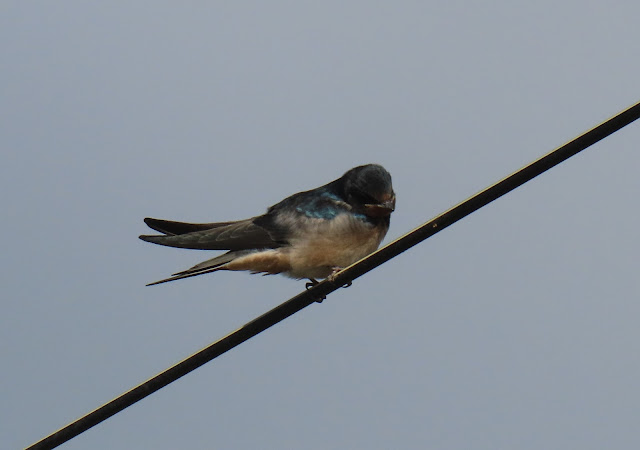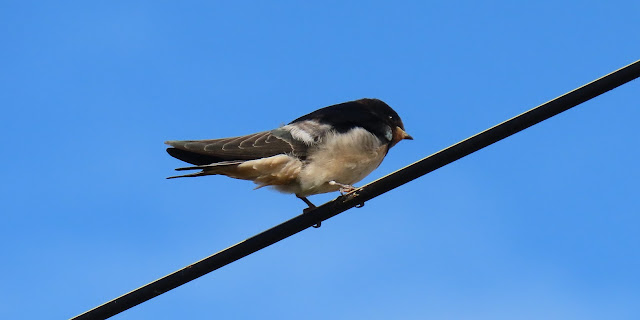A bit of a struggle to get any sort of image in the blustery conditions, but (above) House Martin and (lower two) Sand Martins
Friday, 5th July: A wet, cool and miserable start to the morning, with a very grey, overcast sky and heavy rain, easing slowly to fine drizzle in a strong and persistent W/SW wind force 5-6/7 and a few intermittent drier spells.
Elmer Rocks: A morning that felt more like late autumn than mid-summer and I didn't venture out until the rain eased, doing a sea watch for an hour and a half from around 1000hrs. Visibility wasn't great, with periods of drizzle closing down the view at times, and the only highlight was 7 Common Terns (including a flock of 5) moving W just behind the rock islands....were they dispersing and already departing I wondered! Three Gannets also went W offshore, whilst a couple of Oystercatchers were forced off from their roost on the rocks by a rough sea and heavy waves, before I called it a day with the drizzle closing in again.
Common Tern heading west off Elmer Rocks
Thursday, 4th July: A bright and breezy day, with sunshine, blue sky and white cloud, but still with a brisk and rather cool wind, WNW force 4-5.
Elmer Rocks: There was no sign of the Common Scoter this morning and little activity over the sea, except for a single Curlew that flew W close in, and a large and very distant flock of feeding gulls, right out on the horizon, whilst 7 Oystercatchers were roosing on the rock islands.
Behind the beach, a gathering of c.25 Swifts were high up and feeding, well behind the Poole Place area, and a pair of local Buzzards were soaring, to which a pair of Kestrels took exception with a bit of mobbing. A Green Woodpecker was feeding in the set-aside, whilst nearby a Stock Dove was calling monotonously from its presumed nesting area, as was a Chiffchaff.
It was pleasing to note that a small pod of Dolphins (say around 5 animals) was again present, quite well offshore, and although they could occasionally be seen fairly well (with binoculars) breaching and splashing, trying to get any sort of photo was another matter! The Grey Seal was also present, bobbing around the rock islands from time to time.
Oystercatchers at Elmer Rocks and (Bottle-nosed) Dolphins well offshore - the best images I could manage!
Wednesday, 3rd July: Dull and cloudy again and still with below average temperatures for the time of year, with a moderate WSW wind 3-4 and a few sunny breaks later.
Elmer Rocks: A short visit of about an hour this morning, when it was as expected rather quiet. The Common Scoter was eventually re-found, but it was more distant today, viewed from the Poole Place rocks and some way offshore on the Climping side. Just a single Sandwich Tern flew E during my visit, whilst 3 Mediterranean Gulls were offshore and 4 Oystercatchers were roosting on the rock islands. A Blackcap and a Whitethroat briefly sang from vegetation around the set-aside corner (which I have dubbed 'hotspot corner' - an appropriate name for this little area which becomes a magnet to migrating birds and other wildlife during migration periods. All credit to farmer James Baird for seeing its true value).

The set-aside area at Elmer, close to the small rife, which I have dubbed 'hotspot corner' due to its attractiveness to migrating and breeding birds and other species. Note that this is prvate farmland (I do have permission from the farmer should you see me there) and benefits from a lack of human and animal disturbance, so do please try and respect our own little nature reserve.
Bilsham farm: There was a gathering of larger gulls on the fields and amongst them was a fine couple of Mediterranean Gulls. On the reservoir, 2 female Pochard were unexpected, whilst more regular were Coots (14, including the nesting pair), Mallards (2 females, each with 3 young) and a single Little Grebe.
At Bilsham farm, 2 Mediterranean Gulls on the fields and 2 female Pochards on the reservoir
Tuesday, 2nd July: Another dry, grey, cloudy and cool start with a moderate to brisk N/NW breeze force 4-5; becoming brighter and warmer through the morning - especially in sheltered spots - but with plenty of cloud remaining.
Elmer Rocks: There were a few birds to maintain the interest this morning, the most surprising being a drake Common Scoter loitering just offshore from the rock islands (east end) on the high tide. It may perhaps have been a moulting individual, but it eventually drifted off E towards Climping beach. There was little actually moving offshore except 10 Sandwich Terns (2E, 8W) which included a tight flock of 6 together over the rock islands, whilst 3 Oystercatchers were roosting on the rocks.
At the back of the beach, 3 juvenile Swallows were again on the telegraph wires, awaiting a visit from their parents, and also on the wires were 2 Greenfinch and a family of Linnets. A male Blackcap was seen and heard in the set-aside corner and a single Whitethroat gave a brief burst of song.
Two views of the drake Common Scoter off Elmer Rocks....note the yellowish tone to the bill (upper mandible) - and although the camera has produced a rather orangey tone, it actually appeared more golden yellow in the field. Note also the obvious swelling, or 'knob', at the base of the bill, which suggests an adult bird.
Two of the three Swallows on the telegraph wires this morning, and (bottom) male Linnet (lowest bird) with juveniles, on the same wires.
Monday, 1st July: A very grey morning and feeling unseasonably cool early on, before gradually warming up in the moderate W/NW breeze 3-4.
A brief review: This local blog started at the beginning of the year and has now reported on the local birdlife for a full 6 month period. I always planned to review things at this time, so herewith a few words on how I see it unfolding in the future. It would be fair to say I'm very pleased with the results so far and have certainly enjoyed the local birding scene. I have tried to make my reports of interest to both regular birders and local people with perhaps just a passing interest in nature - indeed it was the interest from locals that inspired this blog in the first place. The number of people using and visiting the site online has increased steadily and justifies the effort that is involved. I'm grateful for the interest shown and the personal responses from people I meet, which makes it worthwhile for me.
So you're all aware, I try to ensure that any local observations I make are duly reported on the blog the same day if at all possible....not several days after, as with some sites I have seen! There will of course be some days when no reports appear and this may for various reasons; perhaps birding elsewhere off the patch, or some unavoidable commitment or even holidays, etc....but be assured I'm always keen to put out the local news as soon as possible thereafter.
You will all know by now that I'm no photographer; point and shoot and hope for the best with a bridge camera is my normal method, but I do at least try to get an image or two to highlight the events of the day. I have established a user-friendly style for my Blogger output which I hope has become familiar with regular readers, whilst the two-colour text helps distinguish the areas of observation (light blue for the MoS parish and green for elsewhere).
I've enjoyed exploring the various areas within the 5 Km patch and some nice species have already been recorded, so it will be interesting to see what the second half of the year holds. Meanwhile, I'm grateful for the continuing interest in this blog, so on we go...do please spread the word!
Yours truly, sea-watching a couple of years ago...ah yes, the famous old two-hat trick to avoid the sun!



























No comments:
Post a Comment